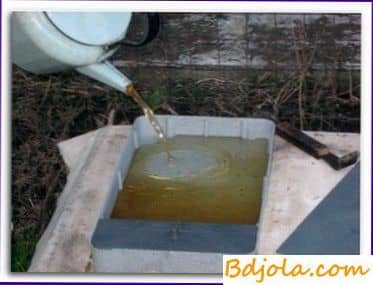
On large apiaries, sucrose dough (kandi) is used successfully for feeding bees in the spring. Top dressing has a number of advantages in comparison with the feeding of sugar syrup. There is no time-consuming work to store, check feeders, transport them, put them in hives, for which it is necessary to remove the roof of the hive, the ceiling “insulating pillows.” After the feeding, all work has to be done in the reverse order. The use of the test does not require any preparatory work: it is put directly on the frame of the nest of bees. The preparation of the dough can be fully mechanized.
In the Institute of Beekeeping, the effectiveness of feeding bees in the spring with sugar syrup and sugar test was compared. It turned out that the families that received the saccharide dough gave better results than those who received the sugar syrup (Table 23).

Additional fertilization with a sugar test ensured the cultivation of bees of higher quality. This is explained by the fact that sugar syrup always strengthens the years of bees, and if there are no flowering plants in nature or they do not secrete nectar, then the intensified years of bees cause only unproductive consumption of sugar (for flights) and other nutrients of bees.
Sugard-shaped dough does not cause summer summer bees and associated losses.
To prepare the sugar test, take 80 kg of powdered sugar 19 kg of honey and 1 liter of water. Sugar powder should not contain lumps, palpable when rubbing between the fingers. The quality of candy depends on the degree of granulation of sugar. In the presence of even small lumps of sugar candy quickly hardens and becomes inaccessible to bees. Honey should be taken mature, preferably from varieties that slowly crystallize. Honey is pre-dissolved. To do this, the amount of honey is placed in a water bath and slowly heated, periodically stirring it.
The temperature of honey should not exceed 50 њ у. When the honey completely dissolves, it is left still in the preheated state for 8-10 hours in order to dissolve the remaining in honey tiny transparent crystals. In the fully dissolved honey, pour in the required amount of boiled water immediately before kneading the dough. The addition of water allows the dough to be slightly more diluted than recommended for other purposes, so that the bees are easier and faster to take the dough.
In the amount of powdered sugar, slowly pour in the heated honey (40-45 њ C) and knead it with the hands as a regular dough. From the dough, cakes weighing 0.8-1 kg, 2-3 cm thick, are prepared. These cakes are laid on metal grids (with holes 3X3 mm) about 20X30 cm in size and placed directly on the upper bars of frames occupied by bees. Take the bees from the bottom, through the holes of the grid, and get on the grid from the sides. A flat cake with dough is covered with a sheet of cellophane from above, so that all the dough is covered. Cellophane protects the dough from rapid drying; when it is not available, the dough can be covered with a sheet of waxed paper.
To reduce the cost of feeding, sometimes sugar powder is mixed on a syrup from inverted sugar. For the inverted syrup, take 74 kg of sugar 18.5 liters of water and 7.5 kg of good fresh honey. All this is stirred and placed for 6-8 days in a temperature of 32-35 њ C. The mixture is stirred periodically. Under the influence of honey invertase, sugar (sucrose) gradually turns into simple sugars – glucose and fructose, which turn into solution. It should be noted that the inversion of sugar should be complete. If sucrose predominates in the solution, the dough will soon turn into a piece of solid sugar, which bees can not use.
Large beekeeping farms mechanize the production of sugar test. Sugar is first dried, passing through a stream of warm air. Then the sugar enters the ball mill, turning it into powdered sugar. The dough is kneaded on the diesmechanical machines used in small bakeries.
Additional fertilizing, dry sugar. If a layer of fine granulated sugar is poured into a wide box with low walls and placed on top of the framework or on the bottom of the hive, then in the absence of honey, the bees will dissolve and take away the grains of sugar. In order to accustom the bees to dry sugar fodder, when the sugar is first put into the beehive it is watered with a honey solution (1 kg of honey per liter of water). Bees at first willingly suck out the liquid part of the feed, and then begin to dissolve grains of sugar. Such sugar is taken only by flying bees. The amount of food taken is independent of the humidity of the air.
Studies have established that bees dissolve sugar not by water from honey crab, but by the secretion of salivary (pharyngeal, pectoral) glands. In the diet prepared by bees from dry sugar, there were many enzymes (invertase and diastase) and little water (15.8%), very high invertase number (663), much sucrose (7%). Thus, when the crystals of sugar dissolve in bees, the activity of the salivary glands increases many times, leading to premature aging and death. Although top-dressing with dry sugar attracts its simplicity, it can not be recommended as an incentive neither in spring, nor in autumn.
Исправление семей с трутовками. Какие мази на пчелином яде.
Feeding base of beekeeping